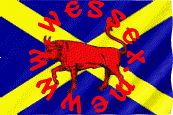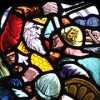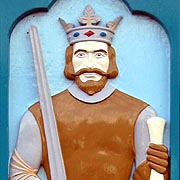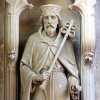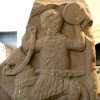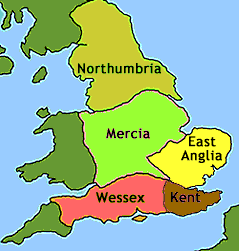Goodbye Rome, Hello England
The period of British history between
the departure of the Roman legions and the Norman Conquest is often
referred to as the 'Dark Ages'. It is called the Dark Ages for a
number of reasons: the written and archaeological record for this
period is scarce and the violence and lawlessness that came about from
a withdrawal of formal government and administration added to its
aura of bleakness.
In the years after the Roman
departure the very identity of Britain changed as we became 'England'.
The native Britons were either assimilated into this new identity, forced
further west into Wales, Cornwall and Cumbria or migrated to other parts
of Europe.
Roman rule had been gradually
accepted in Britain and there were no rebellions or uprisings that
caused the end of Roman Britain. Problems elsewhere in the empire
had necessitated the movement of troops back eastwards and whilst many in Britain expected them to return this was not to be the case.
In 410 AD Britain received confirmation that she was now on her own when
they wrote to Rome asking for help against the invading Picts and were
told in an edict of the Emperor Honorius to look to themselves for their
defence.
Within 30 years Britain had severed
nearly all her ties with Rome and the end of Roman life, particularly
in the more rural areas, was quick and complete. Anglo-Saxons began
to arrive and the taking of control was made easier for them as there
was no administration, Roman or otherwise, to adapt or overthrow.
One important factor in the speedy
collapse of Roman Britain would have been the removal of the Roman
economy. The economy that came over with the Romans had been responsible
for everything that signified Roman Britain. The market for goods had
brought with it towns, housing, clothes and laws. Across the country
pockets of organised society had begun to appear, in contrast to the
self-sufficient nature that had represented Iron Age Britain. After the collapse of Roman Britain many people would have returned to the
almost self-sufficient life that they had lived before the Romans.
The Anglo-Saxon Chronicle begins
its history with the coming of the first Saxons, Hengist and Horsa,
to Britain. They had been invited by King Vortigern to help him in
his battles against the fearsome Picts and Scots who had begun to invade
Britain after the departure of the Romans at the beginning of the 5th
century AD. At first the Saxons helped the Britons to win victories against
their enemy but soon they turned against those who had invited them in
the quest to secure riches and land for themselves.
After victories over the Britons
they were quick to send the message home telling of the 'worthlessness
of the Britons and the excellence of their land' (Anglo-Saxon Chronicle,
AD 449). Soon many more began to invade Britain in the hope of a
profitable return.
At first the British paid off the Saxon raiders with money called 'Danegeld' (raised by taxes) but the Saxons began to want more and the
thought of easy money brought further invasions.
The Anglo-Saxons were from various
tribes - Angles, Saxons, Jutes, Franks etc. They lived in the south
of what is now Denmark and along the sandy coast of north-west Germany
and Holland. Coming from such mountainous and wooded areas they were
particularly interested in the fertile fields of Britain.
The English (as the invaders
called themselves) defeated several British Kings, and set up their own
independent kingdoms. In 585 they founded Mercia (the middle of England
to the Welsh Border) and to the north the English kingdom of Northumbria
stretched from coast to coast. Eastern Britain was now steadily becoming
England.
The natives who refused to succumb to the new rulers were pushed into Wales,
Cornwall and Scotland, killed or sold into slavery.
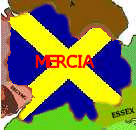
| The Anglo-Saxons and Mercia
The name Mercia comes
from the Old English word 'Mierce' which means boundary, hence
Mercia means 'the land of the boundary people'. This name may be
significant in that part of the Western border of Mercia formed the
boundary between the Anglo-Saxon English and the unconquered Britons
of Wales. Some scholars have suggested that the name may to refer
to the boundaries the area shared with other kingdoms such as Northumbria.
It is thought that the first
Anglo-Saxons in Mercia migrated across from East Anglia, travelling along river valleys. The date given for this is early in the 6th century.
It was settled by
Angles c.500, probably first along the Trent valley.With
the arrival of the Anglo-Saxons in the area many of the Britons would
have moved westwards into more securely British territory. As the
Anglo-Saxons moved west from East Anglia many would have settled
in places along the route that provided good water, fertile soils and
timber for house-building.
As a result the kingdom of Mercia would eventually stretch from Oundle and Northampton in the east and to Hereford and Shrewsbury in the west.
Within this area
lie the Mercian episcopal centre of Lichfield (founded 669) and the important
royal centres of Repton and Tamworth.This kingdom soon developed two main
divisions; Central Mercia and Outer Mercia.
Central Mercia was made up
of one tribal unit whereas Outer Mercia comprised a series of smaller tribes who would eventually owe allegiance to Central Mercia (Mercia - Sarah Zaluckyj, pg 17).
The tribes of Outer Mercia would often remain under the rule of their
original king or leader who would govern on behalf of the King of Mercia,
many of these smaller tribes would eventually be absorbed into the inner
core of the kingdom. Outer Mercia included Herefordshire, Worcestershire,
Shropshire, Cheshire, Northamptonshire, Leicestershire, and
Lincolnshire, Also parts of Oxfordshire and Berkshire.
The early annals apparently indicate that the Kingdom of Mercia began in 585 AD with a man called
Crida or Creod(d)a as king (It is thought that Credenhill [the site
of an Iron Age hillfort] was named after this king).
He was then succeeded by Wibba/Pipba who it is thought reigned between
593 and 597. The first Mercian king mentioned by Bede is Cearl who
reigned for 10 years between 597-607. Cearl was succeeded by Penda, who was to become one of the most famous kings of Mercia.
The kings of Mercia were itinerant people moving from one royal district to another expecting the local nobility to feed and take care of them. This in itself was no small feat and it has been estimated that in the 7th century '10 vats of honey, 300 loaves, 12 ambers (casks) of Welsh ale, 30 of clear ale, 2 full grown cows, or 10 wethers (castrated sheep), 10 geese, 20 hens 10 cheeses an "amber"
full of butter, 5 salmon, 20 pounds of fodder and 100 eels' were required
to feed and water the king and his men for one night. *1
By travelling around the different communities of the large kingdom the king could demonstrate his power
and influence and hopefully discourage uprisings or rebellions. He
could also listen to criminal cases and complaints and so keep a role
in the leadership of his kingdom.
Eventually the smaller Anglo-Saxon
kingdoms of England became absorbed by the larger kingdoms until
the majority of the country was under the control of 7 different main
kingdoms. These were Mercia, Northumbria, Wessex, East Anglia, Sussex.
Kent and Essex.
By the 8th century Mercia had come into her own and was considered one of the three most powerful
kingdoms along with Northumbria and Wessex. By this time her territory
stretched from Kent in the south-east, through London and the Midlands
and as far north as the Derbyshire Peak District.
This area included rich, fertile soils for crop and arable farming and in the west there were large areas of woodland such as the Forest of Dean for timber. There were quarries for stone and lead and salt works
at Droitwich and Cheshire. All these would have combined to create a
profitable industry for Mercia and with wealth her power would have
grown.
| The Kings & Queens of Mercia
The first dynasty of the Mercians was
called Iclingas after Icel, father of Cynewald, grandfather of
Cnebba, and great-grandfather of Creoda of Mercia.
Offa (r. 757-796)
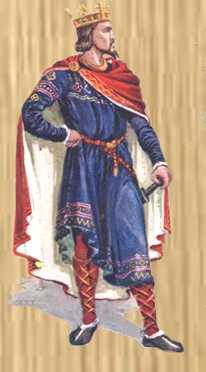
Perhaps the most important of all Mercian Kings was Offa. Offa, King of Mercia seized the throne after a civil war, and established supremacy over many lesser kings.
He consolidated his position by marrying his daughters to
the kings of Wessex and Northumbria, and was the first ruler to be
called 'king of the English'. Offa ruthlessly overcame strong opposition
in southern England. By the end of his reign, Offa was master of all
England south of the Humber. He had a frontier barrier (Offa's Dyke)
built; this continuous ditch and bank ran 149 miles along the boundary
between the Mercian and Welsh kingdoms 'from sea to sea'. Offa had dealings with the emperor Charlemagne (a proposed dynastic marriage between their children came to nothing), and he visited Rome in 792 to strengthen his links with the papacy.
The English
penny (silver currency) was introduced during Offa's reign.
In the first recorded coronation in England,
Offa's son Ecgfrith was consecrated in 787 in Offa's lifetime in
an attempt to secure the succession. However, Ecgfrith died childless,
months after Offa. Offa's success in building a strong unified kingdom
caused resistance in other kingdoms.
The Mercians' defeat at the hands of Egbert
of Wessex at the battle of Ellendun in 825 meant that supremacy passed
to Wessex.
Three places claim to be the capital of Mercia. They are
Lichfield, Repton and Tamworth. Below we list what is known of these
places in the dark ages.
|
Lichfield - Mercia's
Ecclesiastical Centre
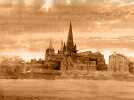
In 669, according
to the Venerable Bede, Chad moved his bishopric to a place called
'Licidfelth'.
The burial in the cathedral of individual
kings of Mercia, such as Celred in 716, further increased the prestige
of Lichfield. In 786, Pope Adrian I raised it at the request of Offa,
King of Mercia, to the dignity of an archbishopric, but in 803 the
primacy was restored to Canterbury. St. Chade, the Patron Saint of Mercia was buried here and many pilgrims visited his Shrine.
The first church probably stood on the site of the present
cathedral, and the settlement quickly grew as the ecclesiastical centre
of the Kingdom of Mercia
| Repton - The Birthplace
of Christianity in Mercia
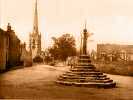
The village dates
back to Anglo-Saxon times and was the place where Christianity was
first preached in the Midlands. In the crypt of the church there
are still well preserved remains of Saxon architecture. Repton church
was the burial place of Mercian Kings. It dates from around 750 AD and
contains the tombs of King Ethelbald of Mercia(ad757), King Wiglaf in
AD840 and his grandson St Wystan who was brutally murdered. The crypt
became a place of pilgramage.
A monastery had been founded following the arrival of Christianity
in Mercia around AD653. It was sacked by the Danes, lay in ruins for
200 years and never rebuilt, but the crypt survived and a church was
built on the old site. Its 212 ft spire is a land mark for miles around.
Repton is known and
sign posted as the capital of Mercia.
| Tamworth
- The Site of The Royal Palace

When Offa came to
the throne of Mercia in 757 AD, he made Tamworth his chief residence
and built a palace there
Offa's
palace was likely a large, thatched, wooden building and as such
it's location is not known, but it might have been north-east of Bolebridge
Street in Tamworth following excavations in 1968, although other possible
locations include the area of the churchyard north of St. Editha's church
or in the Castle Grounds near the castle gatehouse.
Tamworth was
sacked by Danes in the 9th century. Defences in the form of a castle
were constructed against Danish invaders by Ethelfleda Queen of the
kingdom of Mercia.
|

